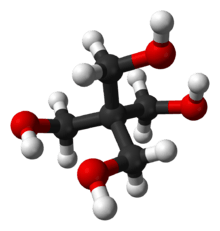Pentaerythritol
 | |
 | |
| Names | |
|---|---|
| Preferred IUPAC name
2,2-Bis(hydroxymethyl)propane-1,3-diol[1] | |
| Other names
2,2-Bis(hydroxymethyl)1,3-propanediol Pentaerythritol[1] Hercules P 6 Monopentaerythritol Tetramethylolmethane THME PETP Pentaerythrite Pentek Hercules Aqualon improved technical PE-200 | |
| Identifiers | |
3D model (JSmol) |
|
| ChemSpider | |
| ECHA InfoCard | 100.003.732 |
| UNII | |
| |
| |
| Properties | |
| C5H12O4 | |
| Molar mass | 136.15 |
| Appearance | white solid |
| Density | 1.396g/cm3 |
| Melting point | 260.5 °C (500.9 °F; 533.6 K) |
| Boiling point | 276 °C (529 °F; 549 K) at 30 mmHg |
| 5.6 g/100 mL at 15 °C | |
| Solubility | Soluble in methanol, ethanol, glycerol, ethylene glycol, formamide; insoluble in acetone, benzene, paraffin, ether, CCl4 |
| Vapor pressure | 0.00000008 mmHg (20°C)[2] |
| Hazards | |
| Flash point | 200.1 °C (392.2 °F; 473.2 K) |
| US health exposure limits (NIOSH): | |
PEL (Permissible) |
TWA 15 mg/m3 (total) TWA 5 mg/m3 (resp)[2] |
REL (Recommended) |
TWA 10 mg/m3 (total) TWA 5 mg/m3 (resp)[2] |
IDLH (Immediate danger) |
N.D.[2] |
Except where otherwise noted, data are given for materials in their standard state (at 25 °C [77 °F], 100 kPa). | |
| Infobox references | |
Pentaerythritol is an organic compound, a white, crystalline solid with the formula C5H12O4. It is a polyol with the neopentane backbone and one hydroxyl group in each of the four terminal carbons. It is a building block for the synthesis and production of explosives, plastics, paints, appliances, cosmetics, and many other important chemicals.
The word pentaerythritol is a portmanteau of penta- in reference to the number of carbon atoms and erythritol, which also possess 4 alcohol groups.
Synthesis
Pentaerythritol was first synthesized in 1891 by German chemist Bernhard Tollens and his student P. Wigand.[3] It may be prepared via a base-catalyzed poly-addition reaction between acetaldehyde and 3 equivalents of formaldehyde, followed by a Cannizzaro reaction with a fourth equivalent of formaldehyde to give the final product.[4]

Uses
Pentaerythritol is a versatile building block for the preparation of many polyfunctionalized compounds, such as the explosive and vasodilator pentaerythritol tetranitrate (PETN) and the polymer cross-linking agent pentaerythritol tetraacrylate.[5] Derivatives of pentaerythritol are components of alkyd resins, varnishes, polyvinyl chloride stabilizers, tall oil esters, and olefin antioxidants. It can be found in transformer oil, plastics, paints, cosmetics, and many other applications.
Medicine
- Pentaerythritol is used to synthesize vasodilator pentaerythritol tetranitrate (PETN).
- The trinitrate is called Pentrinitrol (Petrin).
- The tetraacetate is called Normosterol aka PAG.
- Feneritrol
Explosive
Pentaerythritol is used to synthesize explosive pentaerythritol tetranitrate (PETN).
Dielectric
Halogen-free pentaerythritol esters are also environmentally friendly alternative to conventional electrical transformer fluids, being both readily biodegradable and non-hazardous in water. They advantageously replace polychlorobiphenyl (PCB), and even silicone-based or fluorinated hydrocarbons, as dielectric fluid in transformers. Their low volatility and high flash point give them an excellent resistance to ignition in case of major electrical failure and transformer rupture.
Fire retardant
Pentaerythritol is used as a fire retardant, such as in plastics.[6] Produces thick carbon barrier upon heating protecting the surface substrate. It is a paint ingredient.
Humectant
The hygroscopic property of pentaerythritol is used for skin conditioning by retaining moisture on the skin.[7] It is a cosmetic ingredient.
Lacquer
Pentaerythritol in lacquer, with other nondrying oils or fatty acids, gives hardness, flexibility, water resistance, and polish.[8][9]
References
- 1 2 Nomenclature of Organic Chemistry : IUPAC Recommendations and Preferred Names 2013 (Blue Book). Cambridge: The Royal Society of Chemistry. 2014. p. 691. doi:10.1039/9781849733069-FP001. ISBN 978-0-85404-182-4.
- 1 2 3 4 "NIOSH Pocket Guide to Chemical Hazards #0485". National Institute for Occupational Safety and Health (NIOSH).
- ↑ Tollens, B.; Wigand, P. (1891). "Ueber den Penta-Erythrit, einen aus Formaldehyd und Acetaldehyd synthetisch hergestellten vierwerthigen Alkohol (On pentaerythritol, a quaternary alcohol synthetically produced from formaldehyde and acetaldehyde)". Justus Liebig's Annalen der Chemie (in German). 265 (3): 316–340. doi:10.1002/jlac.18912650303.
- ↑ Schurink, H. B. J. (1925). "Pentaerythritol". Organic Syntheses. 4: 53. doi:10.15227/orgsyn.004.0053. ; Collective Volume, 1, p. 425
- ↑ S. F. Marrian (1948). "The Chemical Reactions of Pentaerythritol and its Derivatives". Chemical Reviews. 43 (1): 149–202. doi:10.1021/cr60134a004. PMID 18876970.
- ↑ B. Pani; S. Sirohi; D. Singh (2013). "Studies on the Effects of Various Flame Retardants on Polypropylene". American Journal of Polymer Science.
- ↑ "Skin Deep".
- ↑ NPCS Board of Consultants & Engineers (2016). "The Complete Book on Adhesives, Glues & Resins Technology (with Process & Formulations) 2nd Revised Edition".
- ↑ NIIR Board of Engineers & Consultants (2005). "Synthetic Resins Technology Handbook".